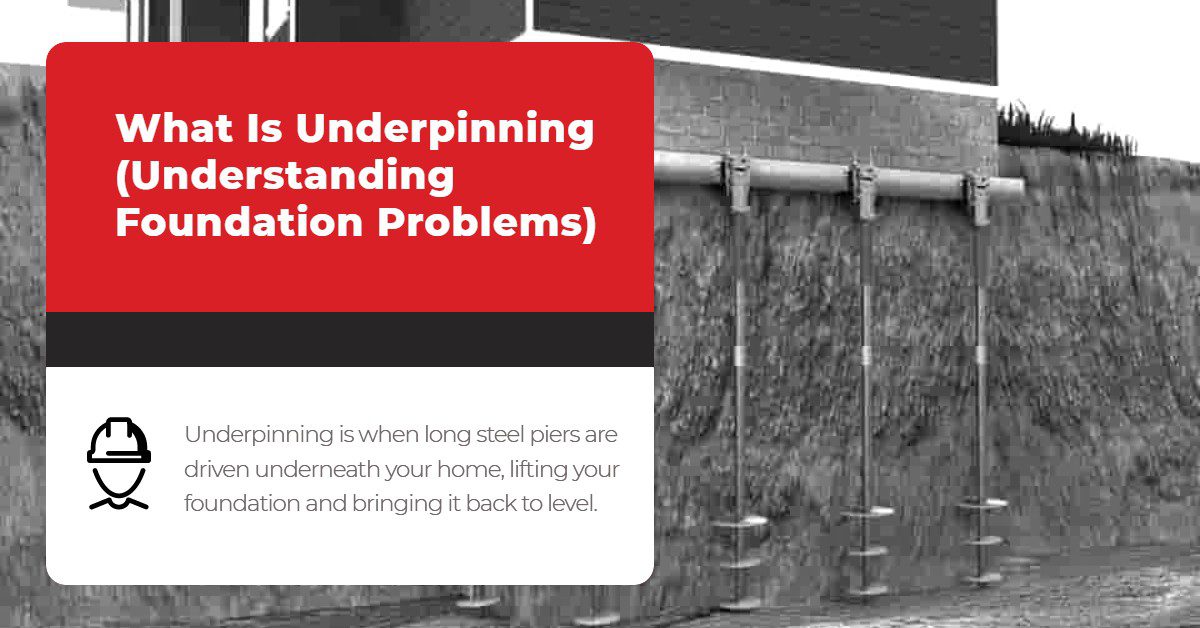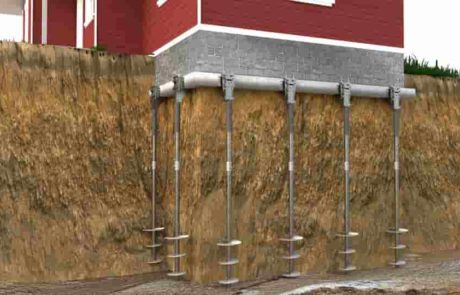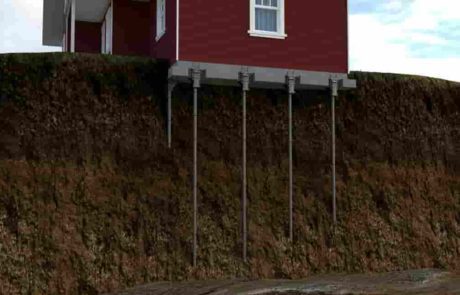If you’re asking yourself what is underpinning or what has underpinning got to do with foundation repair, you’re in the right place. We’re going to go over what underpinning is, when underpinning is needed, different signs you need underpinning, and different types of underpinning solutions.
What Is Underpinning?
Underpinning is when long steel piers are driven underneath your home, lifting your foundation and bringing it back to level. These piers will find stronger soil that your house can rest on, or what’s called the “load-bearing strata.” Underpinning stops any further settlement, strengthens your foundation, and increases the value of your home.
When Is Underpinning Needed?
Underpinning a home is usually needed when the soil below your foundation isn’t strong enough to support it anymore. Your foundation itself could be strong, but if the soil beneath it isn’t, it will sink into the dirt. Here are some common problems that can affect your foundation and the soil underneath it.
- The soil beneath your foundation is expansive – If the soil beneath your foundation contains a lot of clay, it’s considered expansive soil. This means that when the soil absorbs water, it swells up and grows. Then, when the soil dries, it shrinks back down. This growing-shrinking cycle can place stress on your foundation, causing it to sink or develop other problems.
- The soil beneath your foundation wasn’t compacted – Before your foundation is poured, the dirt below must be compacted together so that the soil particles are dense. If builders forgot or improperly compacted the soil, your home and foundation could settle unevenly.
- The soil beneath your foundation is being washed away – If water is draining toward your foundation, it could wash away the soil from under your home. There are a few instances where this could happen.
- From gutters spilling water too close to your foundation.
- From water pouring over the sides of clogged gutters.
- From a sewer line break underneath your home.
- From rainwater pooling in your yard.
- The soil beneath your foundation is swarming with tree roots – If tree roots make their way under your foundation, they can drink all the moisture in your soil, causing the dirt to dry, creating voids. Then, if the tree roots die, they can leave behind pockets that can allow your foundation to sink.
- The soil beneath your foundation is shifting – Also called soil creep, if your home was built on the side of a hill or below a hill, dirt can slide down and cause lateral movement against your foundation. This movement can cause your foundation to shift or sink.
- The soil beneath your foundation has buried material – If any material underneath your foundation begins to degrade, such as buried wood or tools, the pockets left behind can cause your foundation to sink.
Other problems that might make underpinning necessary include natural disasters, poor construction, and renovations.
Signs You Need Underpinning (Foundation Problems)
Everything we mentioned happens underneath your foundation, so it may seem like it’s impossible to detect. But don’t worry. Here are some clear signs your foundation is in trouble and needs underpinning.
- Your doors and windows don’t seem to close all the way – If your foundation is settling or shifting, this will throw off the level of your home, causing your doors and windows to stick or not close properly.
- Your floors are uneven – Floors that are uneven, sunken, sloped, bowed, or cracked from wall to wall are a sign that you may need underpinning.
- Your walls are cracked or bowed – If your foundation walls are cracked or bowing (pushing inward), you definitely have foundation problems. For more information see, Why Horizontal Foundation Cracks Are Dangerous.
- Your walls are separating from the floor and ceiling – Even the slightest separations could indicate you have foundation problems and need underpinning.
- Your wallpaper is tearing – Hidden cracks behind tearing wallpaper could be an indication you need underpinning.
- Your walls are rotating – There are two reasons your walls might rotate: wall shearing and improper sill plate connections.
- Wall shearing – When pressure builds up outside the foundation, the wall can move inwards. If the wall doesn’t bow, it can end up “tipping” or “rotating” inwards. The point at which it rotates depends on the strength of the bottom of the wall vs. the top of the wall.
- Improper sill plate connections – If the sill plate (the wood that sits on top of the foundation that connects the floor joists to the foundation wall top) is not correctly secured or the sill plate rots due to water intrusion, this connection will fail, and the wall can tip inwards. If that connection is strong, the bottom of the wall can shear, causing a horizontal crack within 6″ of the floor while the bottom of the wall can move inwards.
- You have diagonal drywall cracks that run from the corners of your doors and windows to the ceiling – If these cracks are thin, they could be a result of natural settlement. But, if the cracks are long and wide, they could be a sign you need underpinning.
- Your concrete block walls or brick fascia has stair-step cracks – These types of cracks are called “structural” cracks and are an unmistakable indication you have foundation problems and need underpinning.
- Your chimney or porch is separating from the rest of your home – This could either result from a problem with your home’s foundation or the foundation directly under your chimney or porch.
Types Of Underpinning
Here are the most common forms of underpinning.
- Steel push piers – These long piers are pushed deep beneath your foundation until they reach load-bearing soil (strata). Once they reach stronger soil, synchronized hydraulic jacks lift your home back to level.
- Helical piers – These piers are twisted deep beneath your foundation like corkscrews. Once they reach soil strong enough to hold your foundation, hydraulic jacks will lift your home back to normal levels.
Who Provides Underpinning Near Me?
If your home exhibits any of the foundation problems we mentioned above, it’s time to act. Call Foundation Professionals of Florida today! We’re an award-winning and top-performing company servicing Florida, Georgia, Alabama, Mississippi, Louisiana, Tennessee, Kentucky, North Carolina, South Carolina, Virgin Islands, and the Florida Keys. We also provide basement waterproofing, concrete leveling, and more.



